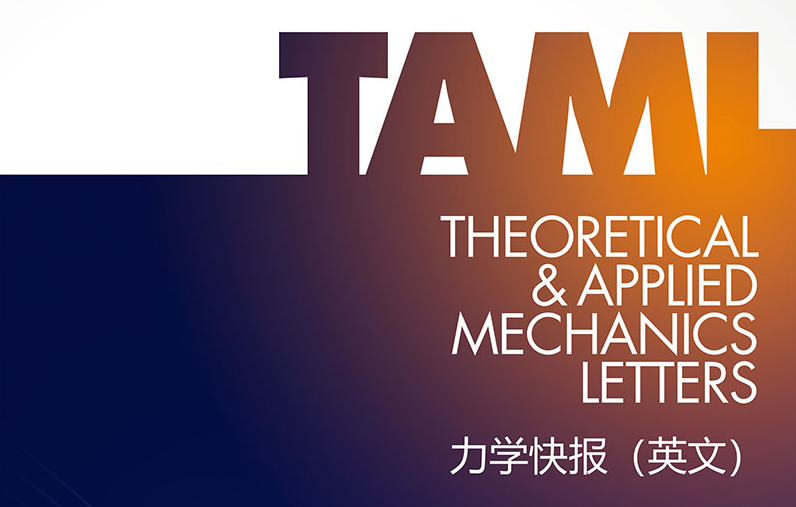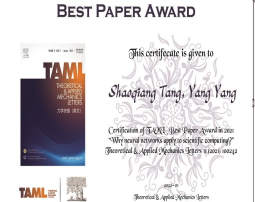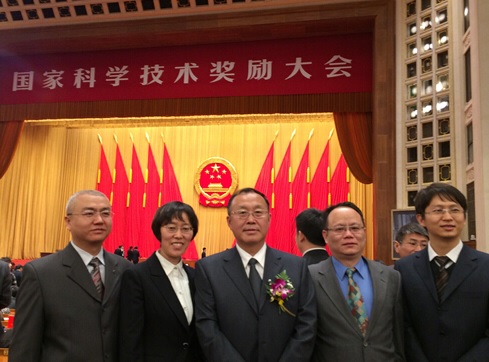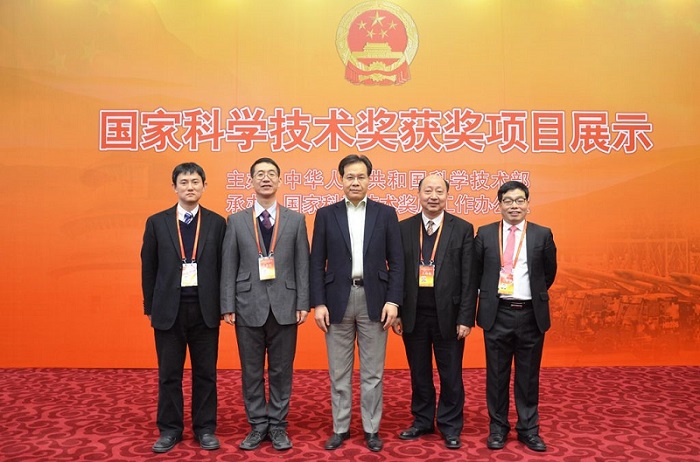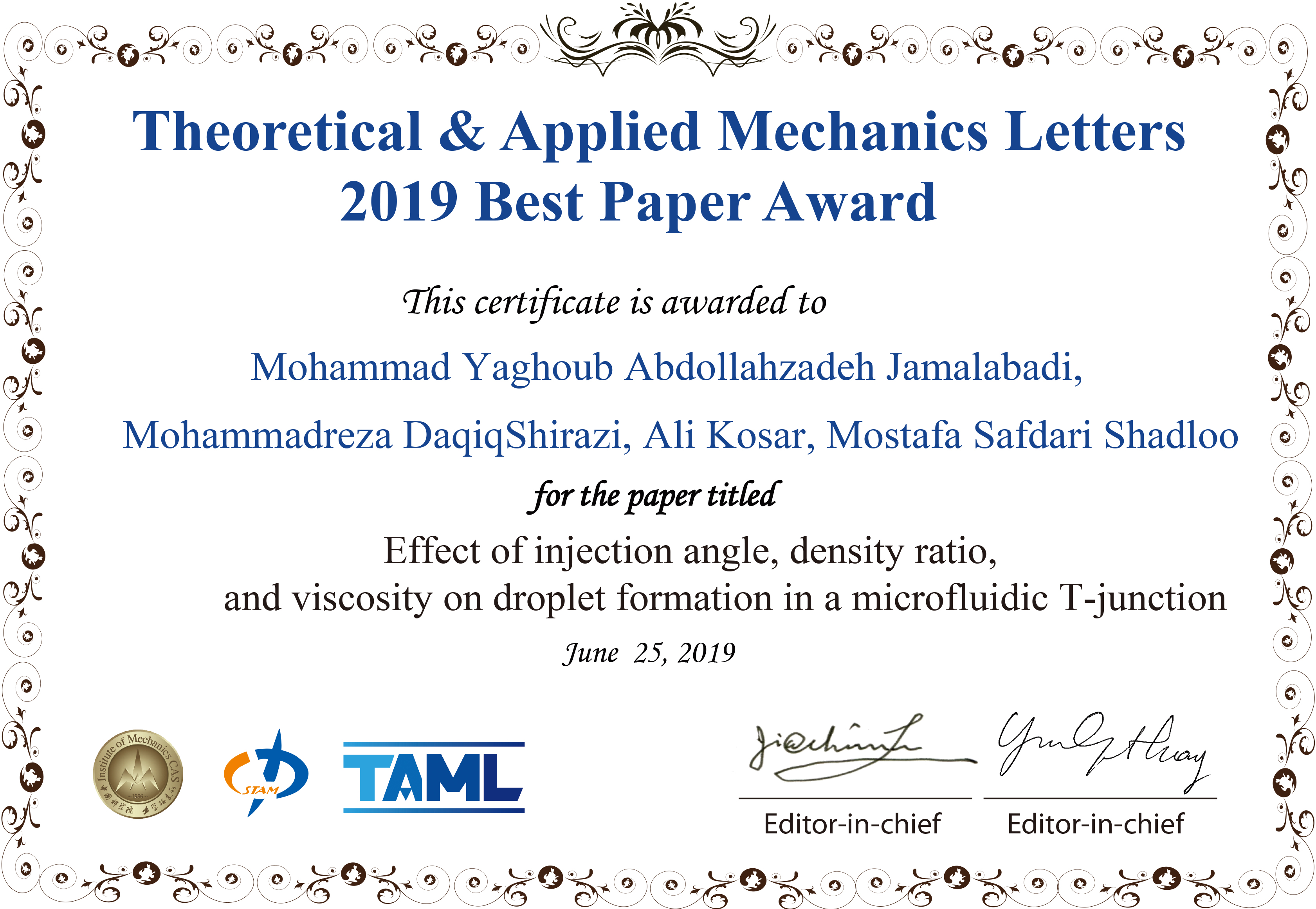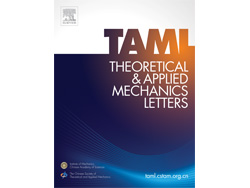Institute of Mechanics,
Chinese Academy of Sciences
2025 Vol.15(3)
Display Mode: |
Theoretical and Applied Mechanics Letters 15 (2025) 100575.
doi: 10.1016/j.taml.2025.100575
Abstract:
This paper experimentally investigates the wave pressure and pore pressure within a sandy seabed around two pipelines under the action of random waves (currents). The experiments revealed that when the random wave plus current cases are compared with the random wave-only case, the forward current promotes wave propagation, whereas the reversed backward current inhibits wave propagation. Furthermore, the wave pressure on the downstream pipeline decreases as the relative spacing ratio increases and increases as the diameter increases. However, alterations in the relative spacing ratio or dimensions of the downstream pipeline exert a negligible influence on the wave pressure of the upstream pipeline. Moreover, the relative spacing ratio between the pipelines and the dimensions of the pipelines considerably influence the pore pressure in the sand bed. When the relative spacing ratio remains constant, increasing the downstream pipeline diameter will increase the pore-water pressure of the soil below the downstream pipeline.
This paper experimentally investigates the wave pressure and pore pressure within a sandy seabed around two pipelines under the action of random waves (currents). The experiments revealed that when the random wave plus current cases are compared with the random wave-only case, the forward current promotes wave propagation, whereas the reversed backward current inhibits wave propagation. Furthermore, the wave pressure on the downstream pipeline decreases as the relative spacing ratio increases and increases as the diameter increases. However, alterations in the relative spacing ratio or dimensions of the downstream pipeline exert a negligible influence on the wave pressure of the upstream pipeline. Moreover, the relative spacing ratio between the pipelines and the dimensions of the pipelines considerably influence the pore pressure in the sand bed. When the relative spacing ratio remains constant, increasing the downstream pipeline diameter will increase the pore-water pressure of the soil below the downstream pipeline.
Theoretical and Applied Mechanics Letters 15 (2025) 100576.
doi: 10.1016/j.taml.2025.100576
Abstract:
This study introduces a novel mathematical model that combines the finite integral transform (FIT) and gradient-enhanced physics-informed neural network (g-PINN) to address thermomechanical problems in functionally graded materials with varying properties. The model employs a multilayer heterostructure homogeneous approach within the FIT to linearize and approximate various parameters, such as the thermal conductivity, specific heat, density, stiffness, thermal expansion coefficient, and Poisson’s ratio. The provided FIT and g-PINN techniques are highly proficient in solving the PDEs of energy equations and equations of motion in a spherical domain, particularly when dealing with space-time dependent boundary conditions. The FIT method simplifies the governing partial differential equations into ordinary differential equations for efficient solutions, whereas the g-PINN bypasses linearization, achieving high accuracy with fewer training data (error < 3.8%). The approach is applied to a spherical pressure vessel, solving energy and motion equations under complex boundary conditions. Furthermore, extensive parametric studies are conducted herein to demonstrate the impact of different property profiles and radial locations on the transient evolution and dynamic propagation of thermomechanical stresses. However, the accuracy of the presented approach is evaluated by comparing the g-PINN results, which have an error of less than 3.8%. Moreover, this model offers significant potential for optimizing materials in high-temperature reactors and chemical plants, improving safety, extending lifespan, and reducing thermal fatigue under extreme processing conditions.
This study introduces a novel mathematical model that combines the finite integral transform (FIT) and gradient-enhanced physics-informed neural network (g-PINN) to address thermomechanical problems in functionally graded materials with varying properties. The model employs a multilayer heterostructure homogeneous approach within the FIT to linearize and approximate various parameters, such as the thermal conductivity, specific heat, density, stiffness, thermal expansion coefficient, and Poisson’s ratio. The provided FIT and g-PINN techniques are highly proficient in solving the PDEs of energy equations and equations of motion in a spherical domain, particularly when dealing with space-time dependent boundary conditions. The FIT method simplifies the governing partial differential equations into ordinary differential equations for efficient solutions, whereas the g-PINN bypasses linearization, achieving high accuracy with fewer training data (error < 3.8%). The approach is applied to a spherical pressure vessel, solving energy and motion equations under complex boundary conditions. Furthermore, extensive parametric studies are conducted herein to demonstrate the impact of different property profiles and radial locations on the transient evolution and dynamic propagation of thermomechanical stresses. However, the accuracy of the presented approach is evaluated by comparing the g-PINN results, which have an error of less than 3.8%. Moreover, this model offers significant potential for optimizing materials in high-temperature reactors and chemical plants, improving safety, extending lifespan, and reducing thermal fatigue under extreme processing conditions.
Theoretical and Applied Mechanics Letters 15 (2025) 100578.
doi: 10.1016/j.taml.2025.100578
Abstract:
Machine learning (ML) models are widely used for predicting undrained shear strength (USS), but interpretability has been a limitation in various studies. Therefore, this study introduced shapley additive explanations (SHAP) to clarify the contribution of each input feature in USS prediction. Three ML models, artificial neural network (ANN), extreme gradient boosting (XGBoost), and random forest (RF), were employed, with accuracy evaluated using mean squared error, mean absolute error, and coefficient of determination (R2). The RF achieved the highest performance with an R2 of 0.82. SHAP analysis identified pre-consolidation stress as a key contributor to USS prediction. SHAP dependence plots reveal that the ANN captures smoother, linear feature-output relationships, while the RF handles complex, non-linear interactions more effectively. This suggests a non-linear relationship between USS and input features, with RF outperforming ANN. These findings highlight SHAP’s role in enhancing interpretability and promoting transparency and reliability in ML predictions for geotechnical applications.
Machine learning (ML) models are widely used for predicting undrained shear strength (USS), but interpretability has been a limitation in various studies. Therefore, this study introduced shapley additive explanations (SHAP) to clarify the contribution of each input feature in USS prediction. Three ML models, artificial neural network (ANN), extreme gradient boosting (XGBoost), and random forest (RF), were employed, with accuracy evaluated using mean squared error, mean absolute error, and coefficient of determination (R2). The RF achieved the highest performance with an R2 of 0.82. SHAP analysis identified pre-consolidation stress as a key contributor to USS prediction. SHAP dependence plots reveal that the ANN captures smoother, linear feature-output relationships, while the RF handles complex, non-linear interactions more effectively. This suggests a non-linear relationship between USS and input features, with RF outperforming ANN. These findings highlight SHAP’s role in enhancing interpretability and promoting transparency and reliability in ML predictions for geotechnical applications.
Theoretical and Applied Mechanics Letters 15 (2025) 100579.
doi: 10.1016/j.taml.2025.100579
Abstract:
Cellular structures, distinguished by their porous characteristics, are frequently adopted in designs aimed at impact isolation, owing to their lightweight attributes and exceptional ability to absorb energy during impact events. Lattice structures often rely on plastic deformation to absorb energy. However, in applications such as sports protection and robotic grasping, there exists a requirement for a reusable structure designed to isolate impacts, which can be effectively achieved by three-dimensional flexible lattice structures. In this work, a theoretical calculation method for soft lattice structures is proposed, and in light of this method, a three-dimensional soft lattice structure aimed at isolating impacts has been carefully designed. The predictive theory for the quasistatic mechanical properties, including stiffness and buckling strength for three-dimensional soft lattice structures is described. On the basis of the quasizero stiffness characteristics inherent in body-centered cubic, octahedral, and regular diamond structures, a soft impact isolation structure is designed. The soft structure, fabricated with thermoplastic polyurethane material, demonstrated a peak impact isolation efficiency of 83%, despite possessing a thickness of 24 mm described. The work provides a novel design methodology for three-dimensional soft lattice structures and supports the development of reusable impact isolation structures for applications such as reconfigurable robots and space capture missions.
Cellular structures, distinguished by their porous characteristics, are frequently adopted in designs aimed at impact isolation, owing to their lightweight attributes and exceptional ability to absorb energy during impact events. Lattice structures often rely on plastic deformation to absorb energy. However, in applications such as sports protection and robotic grasping, there exists a requirement for a reusable structure designed to isolate impacts, which can be effectively achieved by three-dimensional flexible lattice structures. In this work, a theoretical calculation method for soft lattice structures is proposed, and in light of this method, a three-dimensional soft lattice structure aimed at isolating impacts has been carefully designed. The predictive theory for the quasistatic mechanical properties, including stiffness and buckling strength for three-dimensional soft lattice structures is described. On the basis of the quasizero stiffness characteristics inherent in body-centered cubic, octahedral, and regular diamond structures, a soft impact isolation structure is designed. The soft structure, fabricated with thermoplastic polyurethane material, demonstrated a peak impact isolation efficiency of 83%, despite possessing a thickness of 24 mm described. The work provides a novel design methodology for three-dimensional soft lattice structures and supports the development of reusable impact isolation structures for applications such as reconfigurable robots and space capture missions.
Theoretical and Applied Mechanics Letters 15 (2025) 100580.
doi: 10.1016/j.taml.2025.100580
Abstract:
In this study, an improved integrated radial basis function with nonuniform shape parameter is introduced. The proposed shape parameter varies in each support domain and is defined by , where is the maximum distance of any pair of nodes in the support domain. The proposed method is verified and shows good performance. The results are stable and accurate with any number of nodes and an arbitrary nodal distribution. Notably, the support domain should be large enough to obtain accurate results. This method is then applied for transient analysis of curved shell structures made from functionally graded materials with complex geometries. Through several numerical examples, the accuracy of the proposed approach is demonstrated and discussed. Additionally, the influence of various factors on the dynamic behavior of the structures, including the power-law index, different materials, loading conditions, and geometrical parameters of the structures, was investigated.
In this study, an improved integrated radial basis function with nonuniform shape parameter is introduced. The proposed shape parameter varies in each support domain and is defined by , where is the maximum distance of any pair of nodes in the support domain. The proposed method is verified and shows good performance. The results are stable and accurate with any number of nodes and an arbitrary nodal distribution. Notably, the support domain should be large enough to obtain accurate results. This method is then applied for transient analysis of curved shell structures made from functionally graded materials with complex geometries. Through several numerical examples, the accuracy of the proposed approach is demonstrated and discussed. Additionally, the influence of various factors on the dynamic behavior of the structures, including the power-law index, different materials, loading conditions, and geometrical parameters of the structures, was investigated.
Theoretical and Applied Mechanics Letters 15 (2025) 100581.
doi: 10.1016/j.taml.2025.100581
Abstract:
In this study, we numerically investigate the rise of a Taylor bubble in a vertically oscillating round tube. The results show that increasing the oscillation frequency and amplitude reduces the bubble rise velocity, which is consistent with previously reported experimental findings. Analysis of the flow in the annular film region indicates that the influence of tube wall oscillations is minimal. This suggests that the effect of tube oscillations is essentially equivalent to that of an oscillating piston above the bubble, leading to a similar mechanism for bubble deceleration. Using a theoretical formula from the literature, we demonstrate that at sufficiently high frequencies, the amplitude of the tube velocity oscillations becomes the sole control parameter affecting bubble deceleration. This study enhances our understanding of Taylor bubble behavior in mechanically oscillating environments and provides useful insights into the design of control strategies for Taylor bubble motion in vertical slug flows.
In this study, we numerically investigate the rise of a Taylor bubble in a vertically oscillating round tube. The results show that increasing the oscillation frequency and amplitude reduces the bubble rise velocity, which is consistent with previously reported experimental findings. Analysis of the flow in the annular film region indicates that the influence of tube wall oscillations is minimal. This suggests that the effect of tube oscillations is essentially equivalent to that of an oscillating piston above the bubble, leading to a similar mechanism for bubble deceleration. Using a theoretical formula from the literature, we demonstrate that at sufficiently high frequencies, the amplitude of the tube velocity oscillations becomes the sole control parameter affecting bubble deceleration. This study enhances our understanding of Taylor bubble behavior in mechanically oscillating environments and provides useful insights into the design of control strategies for Taylor bubble motion in vertical slug flows.
Theoretical and Applied Mechanics Letters 15 (2025) 100583.
doi: 10.1016/j.taml.2025.100583
Abstract:
Large language models (LLMs) have emerged as powerful tools for addressing a wide range of problems, including those in scientific computing, particularly in solving partial differential equations (PDEs). However, different models exhibit distinct strengths and preferences, resulting in varying levels of performance. In this paper, we compare the capabilities of the most advanced LLMs—DeepSeek, ChatGPT, and Claude—along with their reasoning-optimized versions in addressing computational challenges. Specifically, we evaluate their proficiency in solving traditional numerical problems in scientific computing as well as leveraging scientific machine learning techniques for PDE-based problems. We designed all our experiments so that a nontrivial decision is required, e.g, defining the proper space of input functions for neural operator learning. Our findings show that reasoning and hybrid-reasoning models consistently and significantly outperform non-reasoning ones in solving challenging problems, with ChatGPT o3-mini-high generally offering the fastest reasoning speed.
Large language models (LLMs) have emerged as powerful tools for addressing a wide range of problems, including those in scientific computing, particularly in solving partial differential equations (PDEs). However, different models exhibit distinct strengths and preferences, resulting in varying levels of performance. In this paper, we compare the capabilities of the most advanced LLMs—DeepSeek, ChatGPT, and Claude—along with their reasoning-optimized versions in addressing computational challenges. Specifically, we evaluate their proficiency in solving traditional numerical problems in scientific computing as well as leveraging scientific machine learning techniques for PDE-based problems. We designed all our experiments so that a nontrivial decision is required, e.g, defining the proper space of input functions for neural operator learning. Our findings show that reasoning and hybrid-reasoning models consistently and significantly outperform non-reasoning ones in solving challenging problems, with ChatGPT o3-mini-high generally offering the fastest reasoning speed.
Theoretical and Applied Mechanics Letters 15 (2025) 100584.
doi: 10.1016/j.taml.2025.100584
Abstract:
To meet the intelligent detection needs of underwater defects in large hydropower stations, the hydrodynamic performance of a bionic streamlined remotely operated vehicle containing a thruster protective net structure is numerically simulated via computational fluid dynamics and overlapping mesh technology. The results show that the entity model generates greater hydrodynamic force during steady motion, whereas the square net model experiences greater force and moment during unsteady motion. The lateral and vertical force coefficients of the entity model are 4.32 and 3.13 times greater than those of the square net model in the oblique towing test simulation. The square net model also offers better static and dynamic stability, with a 24.5% increase in dynamic stability, achieving the highest lift-to-drag ratio at attack angles of 6°∼8°. This research provides valuable insights for designing and controlling underwater defect detection vehicles for large hydropower stations.
To meet the intelligent detection needs of underwater defects in large hydropower stations, the hydrodynamic performance of a bionic streamlined remotely operated vehicle containing a thruster protective net structure is numerically simulated via computational fluid dynamics and overlapping mesh technology. The results show that the entity model generates greater hydrodynamic force during steady motion, whereas the square net model experiences greater force and moment during unsteady motion. The lateral and vertical force coefficients of the entity model are 4.32 and 3.13 times greater than those of the square net model in the oblique towing test simulation. The square net model also offers better static and dynamic stability, with a 24.5% increase in dynamic stability, achieving the highest lift-to-drag ratio at attack angles of 6°∼8°. This research provides valuable insights for designing and controlling underwater defect detection vehicles for large hydropower stations.
Theoretical and Applied Mechanics Letters 15 (2025) 100585.
doi: 10.1016/j.taml.2025.100585
Abstract:
The data-driven machine learning paradigm typically requires high-quality, large-scale datasets for training neural networks, which are often unavailable in many scientific and engineering applications. Integrating physics equations into machine learning models, either fully or partially, can mitigate these data requirements and improve generalizability; however, such approaches frequently rely on differentiable programming frameworks. This ability poses significant challenges when legacy or commercial numerical solvers, which are often non-differentiable and difficult to modify without introducing code changes, are integrated. This work addresses these challenges by leveraging the mini-batching iterative ensemble Kalman inversion (EKI) algorithm as a gradient-free training framework for hybrid neural models. The use of stochastic mini-batching significantly enhances the computational efficiency and convergence of EKI, making it well-suited for high-dimensional learning problems. The proposed method is demonstrated for modeling a fiber-reinforced composite plate, where heterogeneous local constitutive laws are parameterized by a trainable neural network embedded within the FEniCS finite element solver. Using the displacement field as indirect data, the hybrid neural FEM solver successfully predicts deformations by learning the local constitutive laws, even for unseen fiber volume fraction distributions and varying test loading conditions. These results demonstrate the effectiveness of iterative EKI in training hybrid neural models with non-differentiable components, paving the way for broader adoption of hybrid neural models in scientific and engineering applications.
The data-driven machine learning paradigm typically requires high-quality, large-scale datasets for training neural networks, which are often unavailable in many scientific and engineering applications. Integrating physics equations into machine learning models, either fully or partially, can mitigate these data requirements and improve generalizability; however, such approaches frequently rely on differentiable programming frameworks. This ability poses significant challenges when legacy or commercial numerical solvers, which are often non-differentiable and difficult to modify without introducing code changes, are integrated. This work addresses these challenges by leveraging the mini-batching iterative ensemble Kalman inversion (EKI) algorithm as a gradient-free training framework for hybrid neural models. The use of stochastic mini-batching significantly enhances the computational efficiency and convergence of EKI, making it well-suited for high-dimensional learning problems. The proposed method is demonstrated for modeling a fiber-reinforced composite plate, where heterogeneous local constitutive laws are parameterized by a trainable neural network embedded within the FEniCS finite element solver. Using the displacement field as indirect data, the hybrid neural FEM solver successfully predicts deformations by learning the local constitutive laws, even for unseen fiber volume fraction distributions and varying test loading conditions. These results demonstrate the effectiveness of iterative EKI in training hybrid neural models with non-differentiable components, paving the way for broader adoption of hybrid neural models in scientific and engineering applications.
Theoretical and Applied Mechanics Letters 15 (2025) 100594.
doi: 10.1016/j.taml.2025.100594
Abstract:
Configuring computational fluid dynamics (CFD) simulations typically demands extensive domain expertise, limiting broader access. Although large language models (LLMs) have advanced scientific computing, their use in automating CFD workflows is underdeveloped. We introduce a novel approach centered on domain-specific LLM adaptation. By fine-tuning Qwen2.5-7B-Instruct on NL2FOAM, our custom dataset of 28,716 natural language-to-OpenFOAM configuration pairs with chain-of-thought (CoT) annotations enables direct translation from natural language descriptions to executable CFD setups. A multi-agent system orchestrates the process, autonomously verifying inputs, generating configurations, running simulations, and correcting errors. Evaluation on a benchmark of 21 diverse flow cases demonstrates state-of-the-art performance, achieving 88.7% solution accuracy and 82.6% first-attempt success rate. This significantly outperforms larger general-purpose models such as Qwen2.5-72B-Instruct, DeepSeek-R1, and Llama3.3-70B-Instruct, while also requiring fewer correction iterations and maintaining high computational efficiency. The results highlight the critical role of domain-specific adaptation in deploying LLM assistants for complex engineering workflows. Our code and fine-tuned model have been deposited athttps://github.com/YYgroup/AutoCFD .
Configuring computational fluid dynamics (CFD) simulations typically demands extensive domain expertise, limiting broader access. Although large language models (LLMs) have advanced scientific computing, their use in automating CFD workflows is underdeveloped. We introduce a novel approach centered on domain-specific LLM adaptation. By fine-tuning Qwen2.5-7B-Instruct on NL2FOAM, our custom dataset of 28,716 natural language-to-OpenFOAM configuration pairs with chain-of-thought (CoT) annotations enables direct translation from natural language descriptions to executable CFD setups. A multi-agent system orchestrates the process, autonomously verifying inputs, generating configurations, running simulations, and correcting errors. Evaluation on a benchmark of 21 diverse flow cases demonstrates state-of-the-art performance, achieving 88.7% solution accuracy and 82.6% first-attempt success rate. This significantly outperforms larger general-purpose models such as Qwen2.5-72B-Instruct, DeepSeek-R1, and Llama3.3-70B-Instruct, while also requiring fewer correction iterations and maintaining high computational efficiency. The results highlight the critical role of domain-specific adaptation in deploying LLM assistants for complex engineering workflows. Our code and fine-tuned model have been deposited at
Theoretical and Applied Mechanics Letters 15 (2025) 100597.
doi: 10.1016/j.taml.2025.100597
Abstract:
This paper investigates the capabilities of large language models (LLMs) to leverage, learn and create knowledge in solving computational fluid dynamics (CFD) problems through three categories of baseline problems. These categories include (1) conventional CFD problems that can be solved using existing numerical methods in LLMs, such as lid-driven cavity flow and the Sod shock tube problem; (2) problems that require new numerical methods beyond those available in LLMs, such as the recently developed Chien-physics-informed neural networks for singularly perturbed convection–diffusion equations; and (3) problems that cannot be solved using existing numerical methods in LLMs, such as the ill-conditioned Hilbert linear algebraic systems. The evaluations indicate that reasoning LLMs overall outperform non-reasoning models in four test cases. Reasoning LLMs show excellent performance for CFD problems according to the tailored prompts, but their current capability in autonomous knowledge exploration and creation needs to be enhanced.
This paper investigates the capabilities of large language models (LLMs) to leverage, learn and create knowledge in solving computational fluid dynamics (CFD) problems through three categories of baseline problems. These categories include (1) conventional CFD problems that can be solved using existing numerical methods in LLMs, such as lid-driven cavity flow and the Sod shock tube problem; (2) problems that require new numerical methods beyond those available in LLMs, such as the recently developed Chien-physics-informed neural networks for singularly perturbed convection–diffusion equations; and (3) problems that cannot be solved using existing numerical methods in LLMs, such as the ill-conditioned Hilbert linear algebraic systems. The evaluations indicate that reasoning LLMs overall outperform non-reasoning models in four test cases. Reasoning LLMs show excellent performance for CFD problems according to the tailored prompts, but their current capability in autonomous knowledge exploration and creation needs to be enhanced.
 Submit a Paper
Submit a Paper
 Subscription
Subscription
News
MORE+
Call for Papers
MORE+
- Crossing-Mechanics Driven by Big Data
- Machine learning in the fluid mechanics research of wind energy
- Mechanics of Origami/Kirigami structures and metamaterials
- New insights and perspectives on impact biomechanics for human tissues: from injury prevention, protection to protective equipment
- Environmental Mechanics for Extreme Natural Events





